CHC30113 Certificate III in Early Childhood: Cultural Safety Project
VerifiedAdded on 2023/05/31
|29
|9214
|182
Homework Assignment
AI Summary
This document is a student assessment workbook for the CHC30113 Certificate III in Early Childhood Education and Care, specifically addressing the unit CHCDIV002, which focuses on promoting Aboriginal and/or Torres Strait Islander cultural safety. The workbook includes an assignment cover sheet, student declaration, and detailed instructions for completing the assessment tasks. It outlines the performance and knowledge evidence required, covering topics such as cultural awareness, historical issues, and strategies to improve communication and service delivery to Indigenous peoples. The assessment tasks include identifying cultural safety issues, modeling cultural safety, developing and evaluating strategies, and workplace tasks. The document also provides information on assessment conditions, reasonable adjustments, student support, and the role of the trainer/assessor. Students are required to submit the workbook with a focus on understanding the theory and elaborating on answers with sufficient detail and referencing. The workbook also details work placement requirements, assessment submission procedures, feedback processes, and the consequences of plagiarism or cheating.
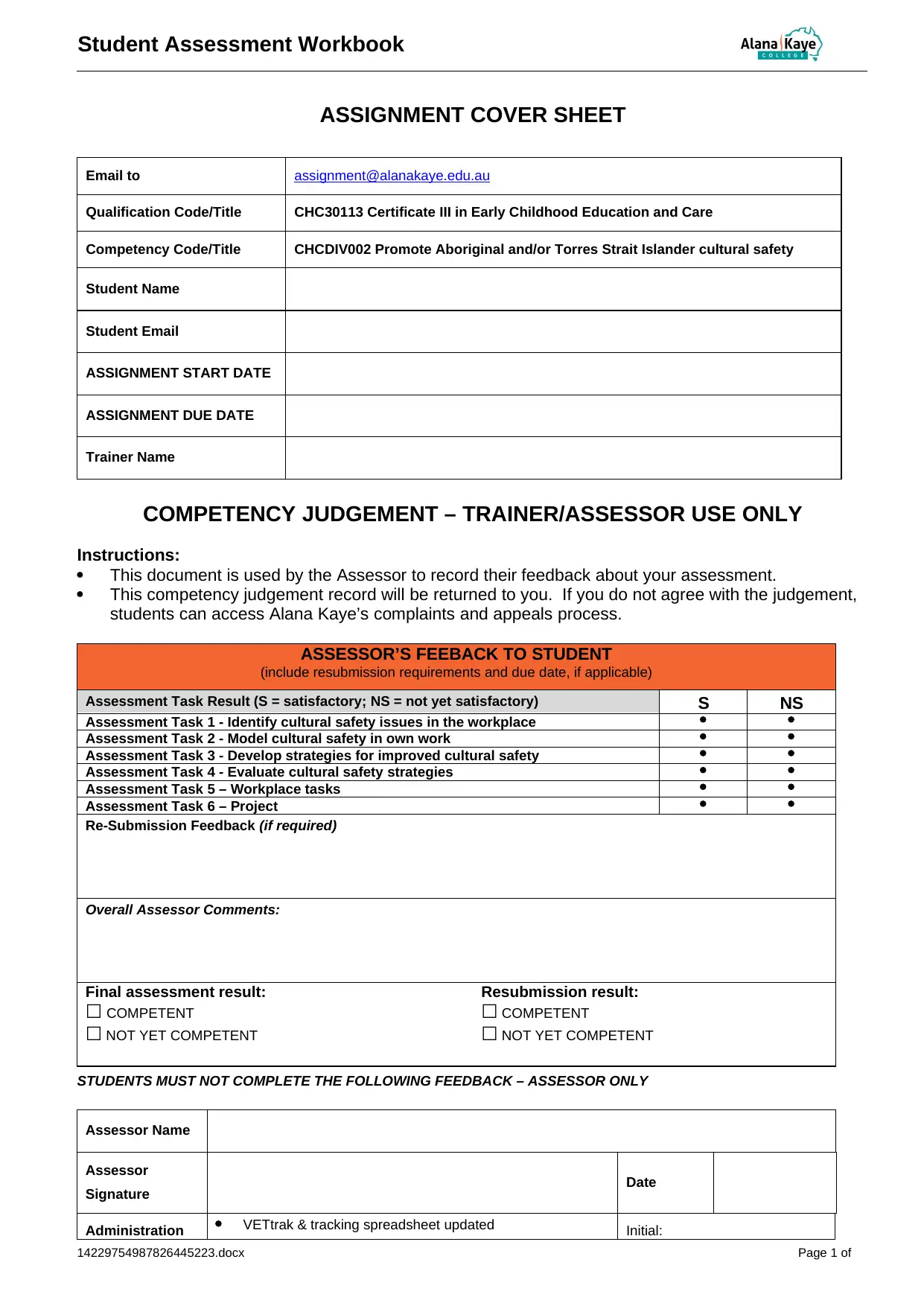
Student Assessment Workbook
ASSIGNMENT COVER SHEET
Email to assignment@alanakaye.edu.au
Qualification Code/Title CHC30113 Certificate III in Early Childhood Education and Care
Competency Code/Title CHCDIV002 Promote Aboriginal and/or Torres Strait Islander cultural safety
Student Name
Student Email
ASSIGNMENT START DATE
ASSIGNMENT DUE DATE
Trainer Name
COMPETENCY JUDGEMENT – TRAINER/ASSESSOR USE ONLY
Instructions:
This document is used by the Assessor to record their feedback about your assessment.
This competency judgement record will be returned to you. If you do not agree with the judgement,
students can access Alana Kaye’s complaints and appeals process.
ASSESSOR’S FEEBACK TO STUDENT
(include resubmission requirements and due date, if applicable)
Assessment Task Result (S = satisfactory; NS = not yet satisfactory) S NS
Assessment Task 1 - Identify cultural safety issues in the workplace
Assessment Task 2 - Model cultural safety in own work
Assessment Task 3 - Develop strategies for improved cultural safety
Assessment Task 4 - Evaluate cultural safety strategies
Assessment Task 5 – Workplace tasks
Assessment Task 6 – Project
Re-Submission Feedback (if required)
Overall Assessor Comments:
Final assessment result: Resubmission result:
☐ COMPETENT ☐ COMPETENT
☐ NOT YET COMPETENT ☐ NOT YET COMPETENT
STUDENTS MUST NOT COMPLETE THE FOLLOWING FEEDBACK – ASSESSOR ONLY
Assessor Name
Assessor
Signature Date
Administration VETtrak & tracking spreadsheet updated Initial:
14229754987826445223.docx Page 1 of
ASSIGNMENT COVER SHEET
Email to assignment@alanakaye.edu.au
Qualification Code/Title CHC30113 Certificate III in Early Childhood Education and Care
Competency Code/Title CHCDIV002 Promote Aboriginal and/or Torres Strait Islander cultural safety
Student Name
Student Email
ASSIGNMENT START DATE
ASSIGNMENT DUE DATE
Trainer Name
COMPETENCY JUDGEMENT – TRAINER/ASSESSOR USE ONLY
Instructions:
This document is used by the Assessor to record their feedback about your assessment.
This competency judgement record will be returned to you. If you do not agree with the judgement,
students can access Alana Kaye’s complaints and appeals process.
ASSESSOR’S FEEBACK TO STUDENT
(include resubmission requirements and due date, if applicable)
Assessment Task Result (S = satisfactory; NS = not yet satisfactory) S NS
Assessment Task 1 - Identify cultural safety issues in the workplace
Assessment Task 2 - Model cultural safety in own work
Assessment Task 3 - Develop strategies for improved cultural safety
Assessment Task 4 - Evaluate cultural safety strategies
Assessment Task 5 – Workplace tasks
Assessment Task 6 – Project
Re-Submission Feedback (if required)
Overall Assessor Comments:
Final assessment result: Resubmission result:
☐ COMPETENT ☐ COMPETENT
☐ NOT YET COMPETENT ☐ NOT YET COMPETENT
STUDENTS MUST NOT COMPLETE THE FOLLOWING FEEDBACK – ASSESSOR ONLY
Assessor Name
Assessor
Signature Date
Administration VETtrak & tracking spreadsheet updated Initial:
14229754987826445223.docx Page 1 of
Paraphrase This Document
Need a fresh take? Get an instant paraphrase of this document with our AI Paraphraser

Student Assessment Workbook
Resulted ACS & CJ scanned & saved
Copy sent to student Date:
STUDENT
Instructions:
Before you start your assessment task, please read the student declaration below
All assignments must be submitted with this attached cover sheet
Assignments submitted without this cover sheet or declaration completed, will be returned to
the student for resubmission
Please keep a copy of your assignment. Your assignment will not be returned to you
Please submit your assignment by hard copy or email the assignment cover sheet with your
assignment to assignment@alanakaye.edu.au
Student Declaration
I confirm: Yes No
I understand the assessment requirements to achieve competence. ☐ ☐
I am ready for assessment. ☐ ☐
I understand the appeals, complaints and grievance procedure (refer to Student
Handbook).
☐ ☐
(only complete if you have special needs). I have advised of my special needs and
any changes to the assessment process have been taken into consideration.
☐ ☐
The work in this assignment is my own work. I declare that this assessment item is
my own work unless otherwise acknowledged and referenced.
☐ ☐
I agree:
This assessment may be accessed by the government (Australian Skills Quality
Authority, Government Funding Agencies) or representatives chosen by Alana
Kaye Training (e.g. Trainers, Consultant, Industry Representatives) to review the
quality and marking of this assessment.
☐ ☐
I have read, understood and accept the above conditions of this assessment.
Signature: Date Submitted:
Cheating and plagiarism: All work submitted must be your own. If a Trainer suspects that you have
been involved in plagiarism, the matter will be referred to the Branch Manager or CEO. If two students
submit the same or very similar assessment both students will need to resubmit their assessment.
14229754987826445223.docx Page 2 of
Resulted ACS & CJ scanned & saved
Copy sent to student Date:
STUDENT
Instructions:
Before you start your assessment task, please read the student declaration below
All assignments must be submitted with this attached cover sheet
Assignments submitted without this cover sheet or declaration completed, will be returned to
the student for resubmission
Please keep a copy of your assignment. Your assignment will not be returned to you
Please submit your assignment by hard copy or email the assignment cover sheet with your
assignment to assignment@alanakaye.edu.au
Student Declaration
I confirm: Yes No
I understand the assessment requirements to achieve competence. ☐ ☐
I am ready for assessment. ☐ ☐
I understand the appeals, complaints and grievance procedure (refer to Student
Handbook).
☐ ☐
(only complete if you have special needs). I have advised of my special needs and
any changes to the assessment process have been taken into consideration.
☐ ☐
The work in this assignment is my own work. I declare that this assessment item is
my own work unless otherwise acknowledged and referenced.
☐ ☐
I agree:
This assessment may be accessed by the government (Australian Skills Quality
Authority, Government Funding Agencies) or representatives chosen by Alana
Kaye Training (e.g. Trainers, Consultant, Industry Representatives) to review the
quality and marking of this assessment.
☐ ☐
I have read, understood and accept the above conditions of this assessment.
Signature: Date Submitted:
Cheating and plagiarism: All work submitted must be your own. If a Trainer suspects that you have
been involved in plagiarism, the matter will be referred to the Branch Manager or CEO. If two students
submit the same or very similar assessment both students will need to resubmit their assessment.
14229754987826445223.docx Page 2 of
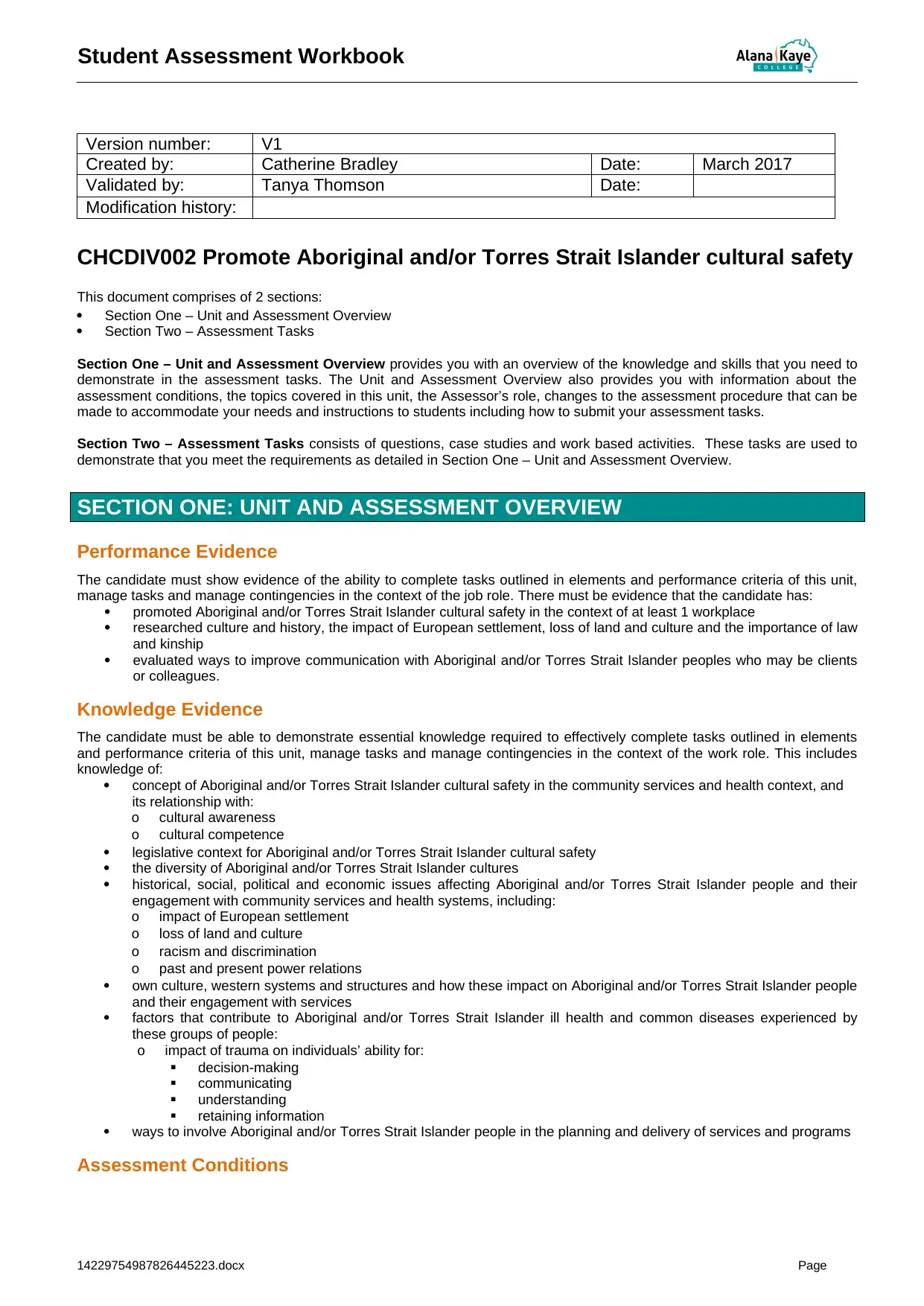
Student Assessment Workbook
Version number: V1
Created by: Catherine Bradley Date: March 2017
Validated by: Tanya Thomson Date:
Modification history:
CHCDIV002 Promote Aboriginal and/or Torres Strait Islander cultural safety
This document comprises of 2 sections:
Section One – Unit and Assessment Overview
Section Two – Assessment Tasks
Section One – Unit and Assessment Overview provides you with an overview of the knowledge and skills that you need to
demonstrate in the assessment tasks. The Unit and Assessment Overview also provides you with information about the
assessment conditions, the topics covered in this unit, the Assessor’s role, changes to the assessment procedure that can be
made to accommodate your needs and instructions to students including how to submit your assessment tasks.
Section Two – Assessment Tasks consists of questions, case studies and work based activities. These tasks are used to
demonstrate that you meet the requirements as detailed in Section One – Unit and Assessment Overview.
SECTION ONE: UNIT AND ASSESSMENT OVERVIEW
Performance Evidence
The candidate must show evidence of the ability to complete tasks outlined in elements and performance criteria of this unit,
manage tasks and manage contingencies in the context of the job role. There must be evidence that the candidate has:
promoted Aboriginal and/or Torres Strait Islander cultural safety in the context of at least 1 workplace
researched culture and history, the impact of European settlement, loss of land and culture and the importance of law
and kinship
evaluated ways to improve communication with Aboriginal and/or Torres Strait Islander peoples who may be clients
or colleagues.
Knowledge Evidence
The candidate must be able to demonstrate essential knowledge required to effectively complete tasks outlined in elements
and performance criteria of this unit, manage tasks and manage contingencies in the context of the work role. This includes
knowledge of:
concept of Aboriginal and/or Torres Strait Islander cultural safety in the community services and health context, and
its relationship with:
o cultural awareness
o cultural competence
legislative context for Aboriginal and/or Torres Strait Islander cultural safety
the diversity of Aboriginal and/or Torres Strait Islander cultures
historical, social, political and economic issues affecting Aboriginal and/or Torres Strait Islander people and their
engagement with community services and health systems, including:
o impact of European settlement
o loss of land and culture
o racism and discrimination
o past and present power relations
own culture, western systems and structures and how these impact on Aboriginal and/or Torres Strait Islander people
and their engagement with services
factors that contribute to Aboriginal and/or Torres Strait Islander ill health and common diseases experienced by
these groups of people:
o impact of trauma on individuals’ ability for:
decision-making
communicating
understanding
retaining information
ways to involve Aboriginal and/or Torres Strait Islander people in the planning and delivery of services and programs
Assessment Conditions
14229754987826445223.docx Page
Version number: V1
Created by: Catherine Bradley Date: March 2017
Validated by: Tanya Thomson Date:
Modification history:
CHCDIV002 Promote Aboriginal and/or Torres Strait Islander cultural safety
This document comprises of 2 sections:
Section One – Unit and Assessment Overview
Section Two – Assessment Tasks
Section One – Unit and Assessment Overview provides you with an overview of the knowledge and skills that you need to
demonstrate in the assessment tasks. The Unit and Assessment Overview also provides you with information about the
assessment conditions, the topics covered in this unit, the Assessor’s role, changes to the assessment procedure that can be
made to accommodate your needs and instructions to students including how to submit your assessment tasks.
Section Two – Assessment Tasks consists of questions, case studies and work based activities. These tasks are used to
demonstrate that you meet the requirements as detailed in Section One – Unit and Assessment Overview.
SECTION ONE: UNIT AND ASSESSMENT OVERVIEW
Performance Evidence
The candidate must show evidence of the ability to complete tasks outlined in elements and performance criteria of this unit,
manage tasks and manage contingencies in the context of the job role. There must be evidence that the candidate has:
promoted Aboriginal and/or Torres Strait Islander cultural safety in the context of at least 1 workplace
researched culture and history, the impact of European settlement, loss of land and culture and the importance of law
and kinship
evaluated ways to improve communication with Aboriginal and/or Torres Strait Islander peoples who may be clients
or colleagues.
Knowledge Evidence
The candidate must be able to demonstrate essential knowledge required to effectively complete tasks outlined in elements
and performance criteria of this unit, manage tasks and manage contingencies in the context of the work role. This includes
knowledge of:
concept of Aboriginal and/or Torres Strait Islander cultural safety in the community services and health context, and
its relationship with:
o cultural awareness
o cultural competence
legislative context for Aboriginal and/or Torres Strait Islander cultural safety
the diversity of Aboriginal and/or Torres Strait Islander cultures
historical, social, political and economic issues affecting Aboriginal and/or Torres Strait Islander people and their
engagement with community services and health systems, including:
o impact of European settlement
o loss of land and culture
o racism and discrimination
o past and present power relations
own culture, western systems and structures and how these impact on Aboriginal and/or Torres Strait Islander people
and their engagement with services
factors that contribute to Aboriginal and/or Torres Strait Islander ill health and common diseases experienced by
these groups of people:
o impact of trauma on individuals’ ability for:
decision-making
communicating
understanding
retaining information
ways to involve Aboriginal and/or Torres Strait Islander people in the planning and delivery of services and programs
Assessment Conditions
14229754987826445223.docx Page
⊘ This is a preview!⊘
Do you want full access?
Subscribe today to unlock all pages.

Trusted by 1+ million students worldwide

Student Assessment Workbook
Skills must have been demonstrated in the workplace or in a simulated environment that reflects workplace conditions. Where
simulation is used, it must reflect real working conditions by modelling industry operating conditions and contingencies, as well
as, using suitable facilities, equipment and resources.
Assessors must satisfy the Standards for Registered Training Organisations (RTOs) 2015/AQTF mandatory competency
requirements for assessors.
In addition, assessment must involve persons approved of by relevant local community elders.
Topics Covered
The topics covered in this unit include:
Identify cultural safety issues in the workplace
Model cultural safety in own work
Develop strategies for improved cultural safety
Evaluate cultural safety strategies
Additional reference material and research website
If you need to refer to a specific resource to complete your assessment task, we will identify the resource within the
assessment task. Additional resources that you may find useful include:
www.earlychildhoodaustralia.org.au
www.ecareconciliationsymposium.com.au
www.education.gov.au/early-years-learning-framework
www.aussiechildcarenetwork.com.au
www.ccccnsw.org.au/wp-content/uploads/EYLF_Ed_Guide_Dec2010.pdf
Reasonable Adjustments
Your Assessor may be able to make adjustments to your assessment based on special needs you may have or if you are a
distance learning student. Please ask your Trainer if you feel that modifications to this assessment are required.
Student Handbook
Please refer to Alana Kaye’s Student Handbook about:
Educational and Student Support Services
Trainer Support
Assessment Strategy
Appeals, Complaints and Grievances Procedures
Role of the Trainer/Assessor
Your Trainer/Assessor will:
answer any questions you might have about the assessment
negotiate assessment activities if reasonable adjustment is required
inform you of any variations to the assessment which may be required if you have any special needs or if you are a
distance based learner
assess your competency by making judgements about the evidenced presented in line with the rules of evidence: validity,
authenticity, currency and sufficiency
give you feedback on the outcomes of the assessment process
counsel you on the outcomes of the assessment including advising you of your right of appeal if you disagree with the
assessment decision
help you address the work health and safety requirements of the assessment setting, if appropriate.
Instructions for students
In order to successfully meet the requirements of this unit you are required to undertake all assessment tasks. Each of these
assessment tasks may have a series of activities or questions that you are required to complete.
Please note that at Certificate III level it is expected that the questions will be answered in a manner that reflects significant
understanding of the theory associated with the unit of competency. You are required to elaborate upon the answer
sufficiently articulating your understating of the underpinning knowledge required for this unit of competency.
As a guide – each question will generally require 1 - 2 paragraphs to effectively address requirements. In some cases, this
may be more. If you, in the course of answering a question, rely upon a text, document, webpage or other source of
information, you must make reference to where this information came from.
You are required to submit:
14229754987826445223.docx Page
Skills must have been demonstrated in the workplace or in a simulated environment that reflects workplace conditions. Where
simulation is used, it must reflect real working conditions by modelling industry operating conditions and contingencies, as well
as, using suitable facilities, equipment and resources.
Assessors must satisfy the Standards for Registered Training Organisations (RTOs) 2015/AQTF mandatory competency
requirements for assessors.
In addition, assessment must involve persons approved of by relevant local community elders.
Topics Covered
The topics covered in this unit include:
Identify cultural safety issues in the workplace
Model cultural safety in own work
Develop strategies for improved cultural safety
Evaluate cultural safety strategies
Additional reference material and research website
If you need to refer to a specific resource to complete your assessment task, we will identify the resource within the
assessment task. Additional resources that you may find useful include:
www.earlychildhoodaustralia.org.au
www.ecareconciliationsymposium.com.au
www.education.gov.au/early-years-learning-framework
www.aussiechildcarenetwork.com.au
www.ccccnsw.org.au/wp-content/uploads/EYLF_Ed_Guide_Dec2010.pdf
Reasonable Adjustments
Your Assessor may be able to make adjustments to your assessment based on special needs you may have or if you are a
distance learning student. Please ask your Trainer if you feel that modifications to this assessment are required.
Student Handbook
Please refer to Alana Kaye’s Student Handbook about:
Educational and Student Support Services
Trainer Support
Assessment Strategy
Appeals, Complaints and Grievances Procedures
Role of the Trainer/Assessor
Your Trainer/Assessor will:
answer any questions you might have about the assessment
negotiate assessment activities if reasonable adjustment is required
inform you of any variations to the assessment which may be required if you have any special needs or if you are a
distance based learner
assess your competency by making judgements about the evidenced presented in line with the rules of evidence: validity,
authenticity, currency and sufficiency
give you feedback on the outcomes of the assessment process
counsel you on the outcomes of the assessment including advising you of your right of appeal if you disagree with the
assessment decision
help you address the work health and safety requirements of the assessment setting, if appropriate.
Instructions for students
In order to successfully meet the requirements of this unit you are required to undertake all assessment tasks. Each of these
assessment tasks may have a series of activities or questions that you are required to complete.
Please note that at Certificate III level it is expected that the questions will be answered in a manner that reflects significant
understanding of the theory associated with the unit of competency. You are required to elaborate upon the answer
sufficiently articulating your understating of the underpinning knowledge required for this unit of competency.
As a guide – each question will generally require 1 - 2 paragraphs to effectively address requirements. In some cases, this
may be more. If you, in the course of answering a question, rely upon a text, document, webpage or other source of
information, you must make reference to where this information came from.
You are required to submit:
14229754987826445223.docx Page
Paraphrase This Document
Need a fresh take? Get an instant paraphrase of this document with our AI Paraphraser
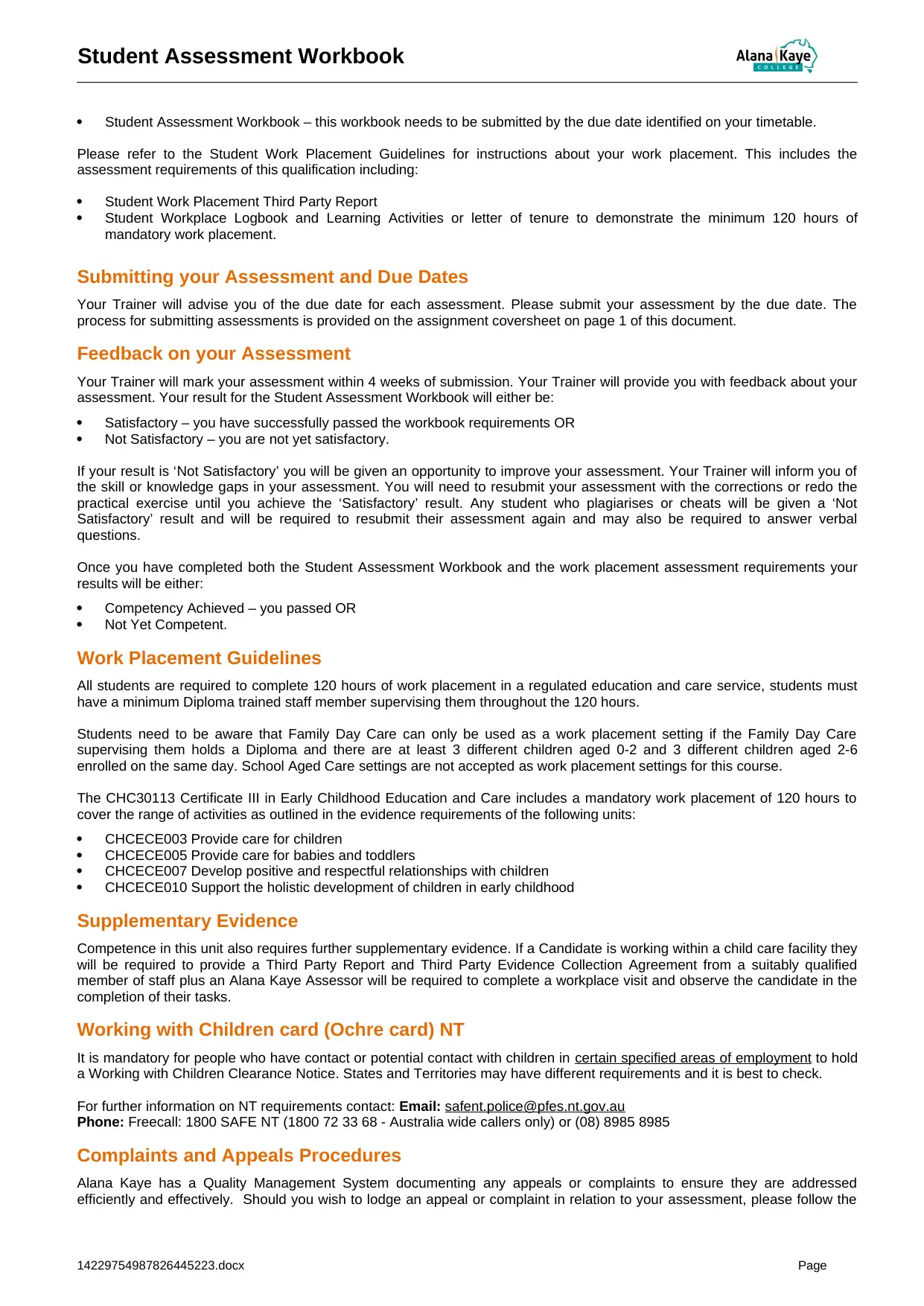
Student Assessment Workbook
Student Assessment Workbook – this workbook needs to be submitted by the due date identified on your timetable.
Please refer to the Student Work Placement Guidelines for instructions about your work placement. This includes the
assessment requirements of this qualification including:
Student Work Placement Third Party Report
Student Workplace Logbook and Learning Activities or letter of tenure to demonstrate the minimum 120 hours of
mandatory work placement.
Submitting your Assessment and Due Dates
Your Trainer will advise you of the due date for each assessment. Please submit your assessment by the due date. The
process for submitting assessments is provided on the assignment coversheet on page 1 of this document.
Feedback on your Assessment
Your Trainer will mark your assessment within 4 weeks of submission. Your Trainer will provide you with feedback about your
assessment. Your result for the Student Assessment Workbook will either be:
Satisfactory – you have successfully passed the workbook requirements OR
Not Satisfactory – you are not yet satisfactory.
If your result is ‘Not Satisfactory’ you will be given an opportunity to improve your assessment. Your Trainer will inform you of
the skill or knowledge gaps in your assessment. You will need to resubmit your assessment with the corrections or redo the
practical exercise until you achieve the ‘Satisfactory’ result. Any student who plagiarises or cheats will be given a ‘Not
Satisfactory’ result and will be required to resubmit their assessment again and may also be required to answer verbal
questions.
Once you have completed both the Student Assessment Workbook and the work placement assessment requirements your
results will be either:
Competency Achieved – you passed OR
Not Yet Competent.
Work Placement Guidelines
All students are required to complete 120 hours of work placement in a regulated education and care service, students must
have a minimum Diploma trained staff member supervising them throughout the 120 hours.
Students need to be aware that Family Day Care can only be used as a work placement setting if the Family Day Care
supervising them holds a Diploma and there are at least 3 different children aged 0-2 and 3 different children aged 2-6
enrolled on the same day. School Aged Care settings are not accepted as work placement settings for this course.
The CHC30113 Certificate III in Early Childhood Education and Care includes a mandatory work placement of 120 hours to
cover the range of activities as outlined in the evidence requirements of the following units:
CHCECE003 Provide care for children
CHCECE005 Provide care for babies and toddlers
CHCECE007 Develop positive and respectful relationships with children
CHCECE010 Support the holistic development of children in early childhood
Supplementary Evidence
Competence in this unit also requires further supplementary evidence. If a Candidate is working within a child care facility they
will be required to provide a Third Party Report and Third Party Evidence Collection Agreement from a suitably qualified
member of staff plus an Alana Kaye Assessor will be required to complete a workplace visit and observe the candidate in the
completion of their tasks.
Working with Children card (Ochre card) NT
It is mandatory for people who have contact or potential contact with children in certain specified areas of employment to hold
a Working with Children Clearance Notice. States and Territories may have different requirements and it is best to check.
For further information on NT requirements contact: Email: safent.police@pfes.nt.gov.au
Phone: Freecall: 1800 SAFE NT (1800 72 33 68 - Australia wide callers only) or (08) 8985 8985
Complaints and Appeals Procedures
Alana Kaye has a Quality Management System documenting any appeals or complaints to ensure they are addressed
efficiently and effectively. Should you wish to lodge an appeal or complaint in relation to your assessment, please follow the
14229754987826445223.docx Page
Student Assessment Workbook – this workbook needs to be submitted by the due date identified on your timetable.
Please refer to the Student Work Placement Guidelines for instructions about your work placement. This includes the
assessment requirements of this qualification including:
Student Work Placement Third Party Report
Student Workplace Logbook and Learning Activities or letter of tenure to demonstrate the minimum 120 hours of
mandatory work placement.
Submitting your Assessment and Due Dates
Your Trainer will advise you of the due date for each assessment. Please submit your assessment by the due date. The
process for submitting assessments is provided on the assignment coversheet on page 1 of this document.
Feedback on your Assessment
Your Trainer will mark your assessment within 4 weeks of submission. Your Trainer will provide you with feedback about your
assessment. Your result for the Student Assessment Workbook will either be:
Satisfactory – you have successfully passed the workbook requirements OR
Not Satisfactory – you are not yet satisfactory.
If your result is ‘Not Satisfactory’ you will be given an opportunity to improve your assessment. Your Trainer will inform you of
the skill or knowledge gaps in your assessment. You will need to resubmit your assessment with the corrections or redo the
practical exercise until you achieve the ‘Satisfactory’ result. Any student who plagiarises or cheats will be given a ‘Not
Satisfactory’ result and will be required to resubmit their assessment again and may also be required to answer verbal
questions.
Once you have completed both the Student Assessment Workbook and the work placement assessment requirements your
results will be either:
Competency Achieved – you passed OR
Not Yet Competent.
Work Placement Guidelines
All students are required to complete 120 hours of work placement in a regulated education and care service, students must
have a minimum Diploma trained staff member supervising them throughout the 120 hours.
Students need to be aware that Family Day Care can only be used as a work placement setting if the Family Day Care
supervising them holds a Diploma and there are at least 3 different children aged 0-2 and 3 different children aged 2-6
enrolled on the same day. School Aged Care settings are not accepted as work placement settings for this course.
The CHC30113 Certificate III in Early Childhood Education and Care includes a mandatory work placement of 120 hours to
cover the range of activities as outlined in the evidence requirements of the following units:
CHCECE003 Provide care for children
CHCECE005 Provide care for babies and toddlers
CHCECE007 Develop positive and respectful relationships with children
CHCECE010 Support the holistic development of children in early childhood
Supplementary Evidence
Competence in this unit also requires further supplementary evidence. If a Candidate is working within a child care facility they
will be required to provide a Third Party Report and Third Party Evidence Collection Agreement from a suitably qualified
member of staff plus an Alana Kaye Assessor will be required to complete a workplace visit and observe the candidate in the
completion of their tasks.
Working with Children card (Ochre card) NT
It is mandatory for people who have contact or potential contact with children in certain specified areas of employment to hold
a Working with Children Clearance Notice. States and Territories may have different requirements and it is best to check.
For further information on NT requirements contact: Email: safent.police@pfes.nt.gov.au
Phone: Freecall: 1800 SAFE NT (1800 72 33 68 - Australia wide callers only) or (08) 8985 8985
Complaints and Appeals Procedures
Alana Kaye has a Quality Management System documenting any appeals or complaints to ensure they are addressed
efficiently and effectively. Should you wish to lodge an appeal or complaint in relation to your assessment, please follow the
14229754987826445223.docx Page
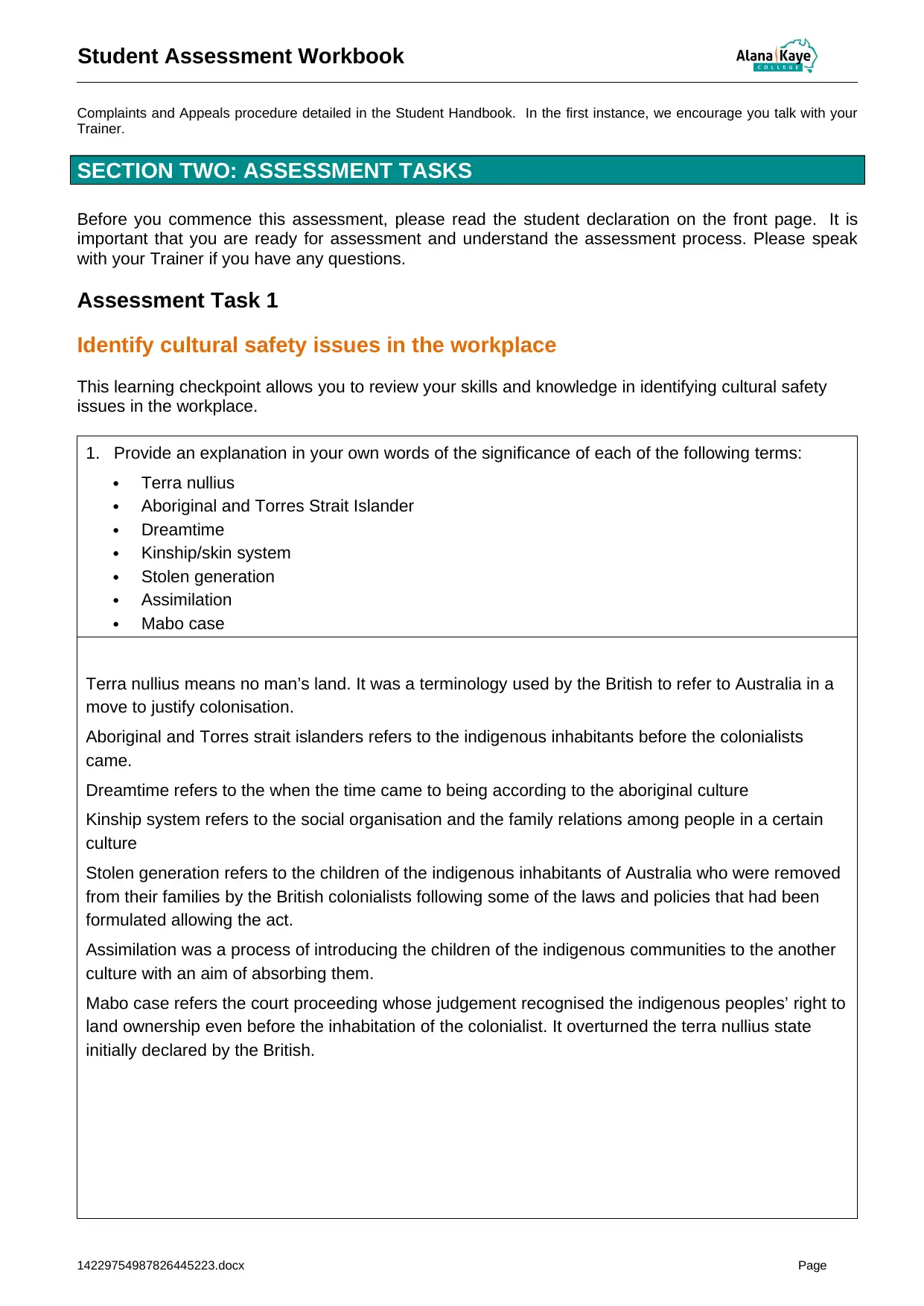
Student Assessment Workbook
Complaints and Appeals procedure detailed in the Student Handbook. In the first instance, we encourage you talk with your
Trainer.
SECTION TWO: ASSESSMENT TASKS
Before you commence this assessment, please read the student declaration on the front page. It is
important that you are ready for assessment and understand the assessment process. Please speak
with your Trainer if you have any questions.
Assessment Task 1
Identify cultural safety issues in the workplace
This learning checkpoint allows you to review your skills and knowledge in identifying cultural safety
issues in the workplace.
1. Provide an explanation in your own words of the significance of each of the following terms:
Terra nullius
Aboriginal and Torres Strait Islander
Dreamtime
Kinship/skin system
Stolen generation
Assimilation
Mabo case
Terra nullius means no man’s land. It was a terminology used by the British to refer to Australia in a
move to justify colonisation.
Aboriginal and Torres strait islanders refers to the indigenous inhabitants before the colonialists
came.
Dreamtime refers to the when the time came to being according to the aboriginal culture
Kinship system refers to the social organisation and the family relations among people in a certain
culture
Stolen generation refers to the children of the indigenous inhabitants of Australia who were removed
from their families by the British colonialists following some of the laws and policies that had been
formulated allowing the act.
Assimilation was a process of introducing the children of the indigenous communities to the another
culture with an aim of absorbing them.
Mabo case refers the court proceeding whose judgement recognised the indigenous peoples’ right to
land ownership even before the inhabitation of the colonialist. It overturned the terra nullius state
initially declared by the British.
14229754987826445223.docx Page
Complaints and Appeals procedure detailed in the Student Handbook. In the first instance, we encourage you talk with your
Trainer.
SECTION TWO: ASSESSMENT TASKS
Before you commence this assessment, please read the student declaration on the front page. It is
important that you are ready for assessment and understand the assessment process. Please speak
with your Trainer if you have any questions.
Assessment Task 1
Identify cultural safety issues in the workplace
This learning checkpoint allows you to review your skills and knowledge in identifying cultural safety
issues in the workplace.
1. Provide an explanation in your own words of the significance of each of the following terms:
Terra nullius
Aboriginal and Torres Strait Islander
Dreamtime
Kinship/skin system
Stolen generation
Assimilation
Mabo case
Terra nullius means no man’s land. It was a terminology used by the British to refer to Australia in a
move to justify colonisation.
Aboriginal and Torres strait islanders refers to the indigenous inhabitants before the colonialists
came.
Dreamtime refers to the when the time came to being according to the aboriginal culture
Kinship system refers to the social organisation and the family relations among people in a certain
culture
Stolen generation refers to the children of the indigenous inhabitants of Australia who were removed
from their families by the British colonialists following some of the laws and policies that had been
formulated allowing the act.
Assimilation was a process of introducing the children of the indigenous communities to the another
culture with an aim of absorbing them.
Mabo case refers the court proceeding whose judgement recognised the indigenous peoples’ right to
land ownership even before the inhabitation of the colonialist. It overturned the terra nullius state
initially declared by the British.
14229754987826445223.docx Page
⊘ This is a preview!⊘
Do you want full access?
Subscribe today to unlock all pages.

Trusted by 1+ million students worldwide
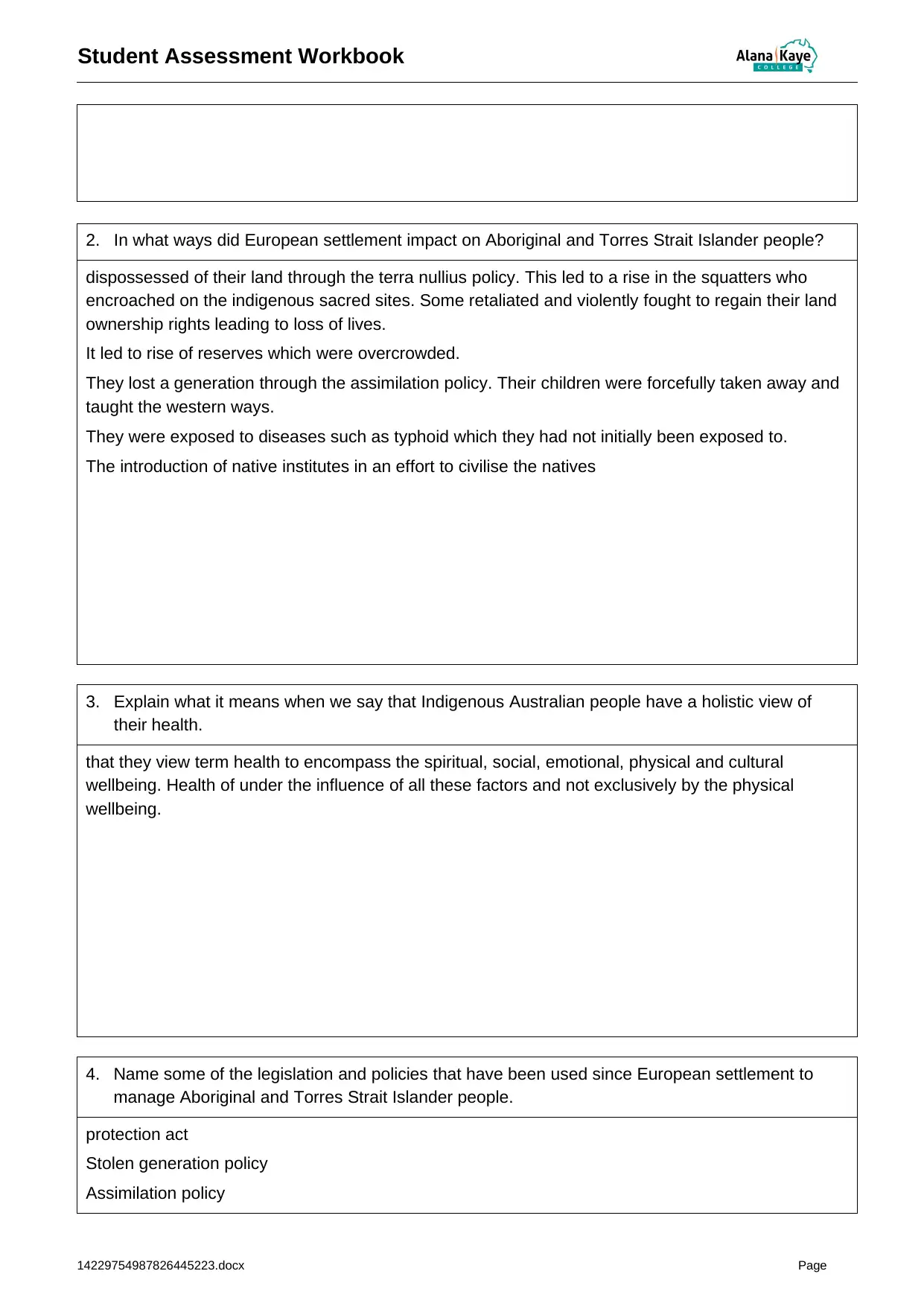
Student Assessment Workbook
2. In what ways did European settlement impact on Aboriginal and Torres Strait Islander people?
dispossessed of their land through the terra nullius policy. This led to a rise in the squatters who
encroached on the indigenous sacred sites. Some retaliated and violently fought to regain their land
ownership rights leading to loss of lives.
It led to rise of reserves which were overcrowded.
They lost a generation through the assimilation policy. Their children were forcefully taken away and
taught the western ways.
They were exposed to diseases such as typhoid which they had not initially been exposed to.
The introduction of native institutes in an effort to civilise the natives
3. Explain what it means when we say that Indigenous Australian people have a holistic view of
their health.
that they view term health to encompass the spiritual, social, emotional, physical and cultural
wellbeing. Health of under the influence of all these factors and not exclusively by the physical
wellbeing.
4. Name some of the legislation and policies that have been used since European settlement to
manage Aboriginal and Torres Strait Islander people.
protection act
Stolen generation policy
Assimilation policy
14229754987826445223.docx Page
2. In what ways did European settlement impact on Aboriginal and Torres Strait Islander people?
dispossessed of their land through the terra nullius policy. This led to a rise in the squatters who
encroached on the indigenous sacred sites. Some retaliated and violently fought to regain their land
ownership rights leading to loss of lives.
It led to rise of reserves which were overcrowded.
They lost a generation through the assimilation policy. Their children were forcefully taken away and
taught the western ways.
They were exposed to diseases such as typhoid which they had not initially been exposed to.
The introduction of native institutes in an effort to civilise the natives
3. Explain what it means when we say that Indigenous Australian people have a holistic view of
their health.
that they view term health to encompass the spiritual, social, emotional, physical and cultural
wellbeing. Health of under the influence of all these factors and not exclusively by the physical
wellbeing.
4. Name some of the legislation and policies that have been used since European settlement to
manage Aboriginal and Torres Strait Islander people.
protection act
Stolen generation policy
Assimilation policy
14229754987826445223.docx Page
Paraphrase This Document
Need a fresh take? Get an instant paraphrase of this document with our AI Paraphraser
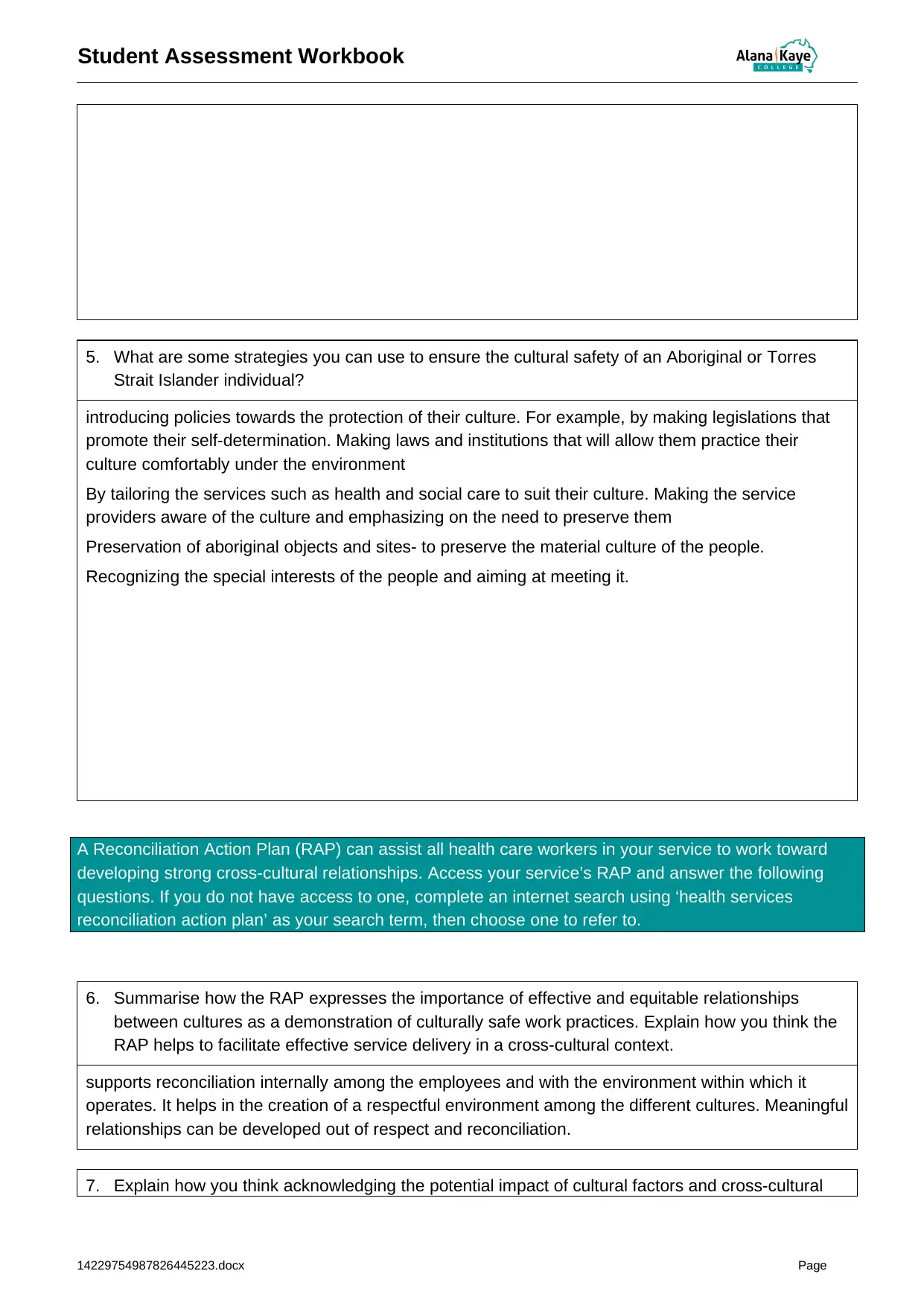
Student Assessment Workbook
5. What are some strategies you can use to ensure the cultural safety of an Aboriginal or Torres
Strait Islander individual?
introducing policies towards the protection of their culture. For example, by making legislations that
promote their self-determination. Making laws and institutions that will allow them practice their
culture comfortably under the environment
By tailoring the services such as health and social care to suit their culture. Making the service
providers aware of the culture and emphasizing on the need to preserve them
Preservation of aboriginal objects and sites- to preserve the material culture of the people.
Recognizing the special interests of the people and aiming at meeting it.
A Reconciliation Action Plan (RAP) can assist all health care workers in your service to work toward
developing strong cross-cultural relationships. Access your service’s RAP and answer the following
questions. If you do not have access to one, complete an internet search using ‘health services
reconciliation action plan’ as your search term, then choose one to refer to.
6. Summarise how the RAP expresses the importance of effective and equitable relationships
between cultures as a demonstration of culturally safe work practices. Explain how you think the
RAP helps to facilitate effective service delivery in a cross-cultural context.
supports reconciliation internally among the employees and with the environment within which it
operates. It helps in the creation of a respectful environment among the different cultures. Meaningful
relationships can be developed out of respect and reconciliation.
7. Explain how you think acknowledging the potential impact of cultural factors and cross-cultural
14229754987826445223.docx Page
5. What are some strategies you can use to ensure the cultural safety of an Aboriginal or Torres
Strait Islander individual?
introducing policies towards the protection of their culture. For example, by making legislations that
promote their self-determination. Making laws and institutions that will allow them practice their
culture comfortably under the environment
By tailoring the services such as health and social care to suit their culture. Making the service
providers aware of the culture and emphasizing on the need to preserve them
Preservation of aboriginal objects and sites- to preserve the material culture of the people.
Recognizing the special interests of the people and aiming at meeting it.
A Reconciliation Action Plan (RAP) can assist all health care workers in your service to work toward
developing strong cross-cultural relationships. Access your service’s RAP and answer the following
questions. If you do not have access to one, complete an internet search using ‘health services
reconciliation action plan’ as your search term, then choose one to refer to.
6. Summarise how the RAP expresses the importance of effective and equitable relationships
between cultures as a demonstration of culturally safe work practices. Explain how you think the
RAP helps to facilitate effective service delivery in a cross-cultural context.
supports reconciliation internally among the employees and with the environment within which it
operates. It helps in the creation of a respectful environment among the different cultures. Meaningful
relationships can be developed out of respect and reconciliation.
7. Explain how you think acknowledging the potential impact of cultural factors and cross-cultural
14229754987826445223.docx Page
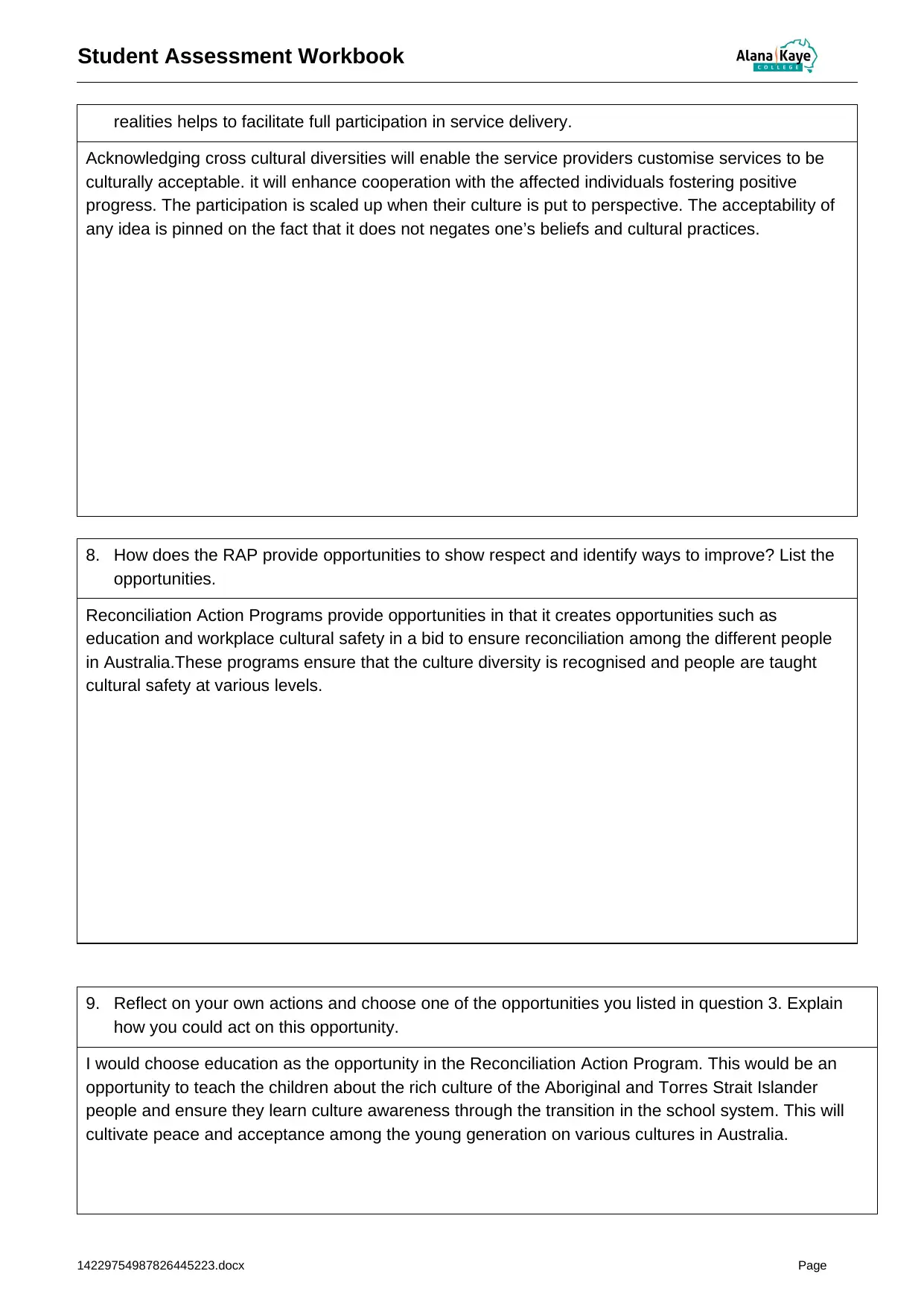
Student Assessment Workbook
realities helps to facilitate full participation in service delivery.
Acknowledging cross cultural diversities will enable the service providers customise services to be
culturally acceptable. it will enhance cooperation with the affected individuals fostering positive
progress. The participation is scaled up when their culture is put to perspective. The acceptability of
any idea is pinned on the fact that it does not negates one’s beliefs and cultural practices.
8. How does the RAP provide opportunities to show respect and identify ways to improve? List the
opportunities.
Reconciliation Action Programs provide opportunities in that it creates opportunities such as
education and workplace cultural safety in a bid to ensure reconciliation among the different people
in Australia.These programs ensure that the culture diversity is recognised and people are taught
cultural safety at various levels.
9. Reflect on your own actions and choose one of the opportunities you listed in question 3. Explain
how you could act on this opportunity.
I would choose education as the opportunity in the Reconciliation Action Program. This would be an
opportunity to teach the children about the rich culture of the Aboriginal and Torres Strait Islander
people and ensure they learn culture awareness through the transition in the school system. This will
cultivate peace and acceptance among the young generation on various cultures in Australia.
14229754987826445223.docx Page
realities helps to facilitate full participation in service delivery.
Acknowledging cross cultural diversities will enable the service providers customise services to be
culturally acceptable. it will enhance cooperation with the affected individuals fostering positive
progress. The participation is scaled up when their culture is put to perspective. The acceptability of
any idea is pinned on the fact that it does not negates one’s beliefs and cultural practices.
8. How does the RAP provide opportunities to show respect and identify ways to improve? List the
opportunities.
Reconciliation Action Programs provide opportunities in that it creates opportunities such as
education and workplace cultural safety in a bid to ensure reconciliation among the different people
in Australia.These programs ensure that the culture diversity is recognised and people are taught
cultural safety at various levels.
9. Reflect on your own actions and choose one of the opportunities you listed in question 3. Explain
how you could act on this opportunity.
I would choose education as the opportunity in the Reconciliation Action Program. This would be an
opportunity to teach the children about the rich culture of the Aboriginal and Torres Strait Islander
people and ensure they learn culture awareness through the transition in the school system. This will
cultivate peace and acceptance among the young generation on various cultures in Australia.
14229754987826445223.docx Page
⊘ This is a preview!⊘
Do you want full access?
Subscribe today to unlock all pages.

Trusted by 1+ million students worldwide
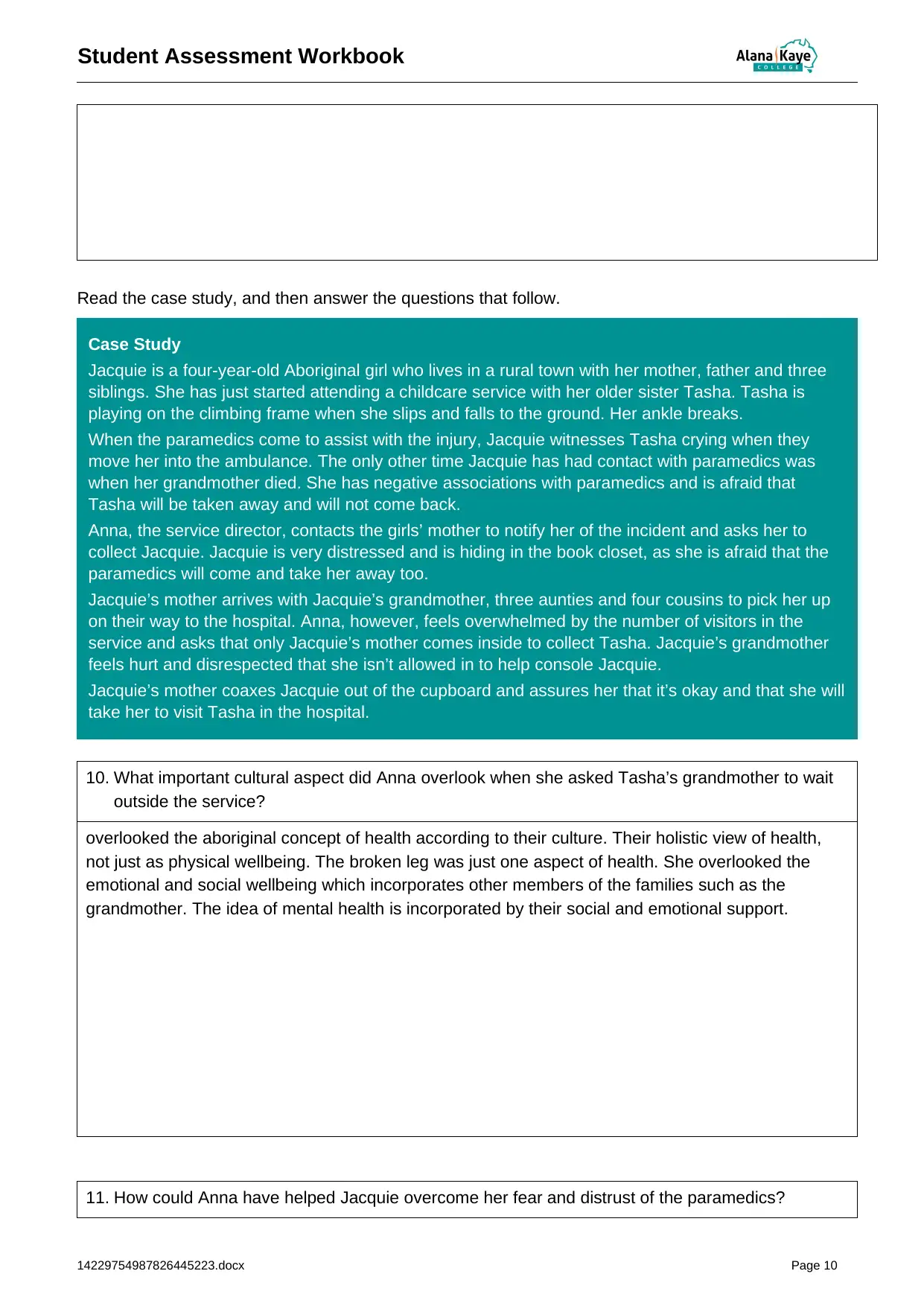
Student Assessment Workbook
Read the case study, and then answer the questions that follow.
Case Study
Jacquie is a four-year-old Aboriginal girl who lives in a rural town with her mother, father and three
siblings. She has just started attending a childcare service with her older sister Tasha. Tasha is
playing on the climbing frame when she slips and falls to the ground. Her ankle breaks.
When the paramedics come to assist with the injury, Jacquie witnesses Tasha crying when they
move her into the ambulance. The only other time Jacquie has had contact with paramedics was
when her grandmother died. She has negative associations with paramedics and is afraid that
Tasha will be taken away and will not come back.
Anna, the service director, contacts the girls’ mother to notify her of the incident and asks her to
collect Jacquie. Jacquie is very distressed and is hiding in the book closet, as she is afraid that the
paramedics will come and take her away too.
Jacquie’s mother arrives with Jacquie’s grandmother, three aunties and four cousins to pick her up
on their way to the hospital. Anna, however, feels overwhelmed by the number of visitors in the
service and asks that only Jacquie’s mother comes inside to collect Tasha. Jacquie’s grandmother
feels hurt and disrespected that she isn’t allowed in to help console Jacquie.
Jacquie’s mother coaxes Jacquie out of the cupboard and assures her that it’s okay and that she will
take her to visit Tasha in the hospital.
10. What important cultural aspect did Anna overlook when she asked Tasha’s grandmother to wait
outside the service?
overlooked the aboriginal concept of health according to their culture. Their holistic view of health,
not just as physical wellbeing. The broken leg was just one aspect of health. She overlooked the
emotional and social wellbeing which incorporates other members of the families such as the
grandmother. The idea of mental health is incorporated by their social and emotional support.
11. How could Anna have helped Jacquie overcome her fear and distrust of the paramedics?
14229754987826445223.docx Page 10
Read the case study, and then answer the questions that follow.
Case Study
Jacquie is a four-year-old Aboriginal girl who lives in a rural town with her mother, father and three
siblings. She has just started attending a childcare service with her older sister Tasha. Tasha is
playing on the climbing frame when she slips and falls to the ground. Her ankle breaks.
When the paramedics come to assist with the injury, Jacquie witnesses Tasha crying when they
move her into the ambulance. The only other time Jacquie has had contact with paramedics was
when her grandmother died. She has negative associations with paramedics and is afraid that
Tasha will be taken away and will not come back.
Anna, the service director, contacts the girls’ mother to notify her of the incident and asks her to
collect Jacquie. Jacquie is very distressed and is hiding in the book closet, as she is afraid that the
paramedics will come and take her away too.
Jacquie’s mother arrives with Jacquie’s grandmother, three aunties and four cousins to pick her up
on their way to the hospital. Anna, however, feels overwhelmed by the number of visitors in the
service and asks that only Jacquie’s mother comes inside to collect Tasha. Jacquie’s grandmother
feels hurt and disrespected that she isn’t allowed in to help console Jacquie.
Jacquie’s mother coaxes Jacquie out of the cupboard and assures her that it’s okay and that she will
take her to visit Tasha in the hospital.
10. What important cultural aspect did Anna overlook when she asked Tasha’s grandmother to wait
outside the service?
overlooked the aboriginal concept of health according to their culture. Their holistic view of health,
not just as physical wellbeing. The broken leg was just one aspect of health. She overlooked the
emotional and social wellbeing which incorporates other members of the families such as the
grandmother. The idea of mental health is incorporated by their social and emotional support.
11. How could Anna have helped Jacquie overcome her fear and distrust of the paramedics?
14229754987826445223.docx Page 10
Paraphrase This Document
Need a fresh take? Get an instant paraphrase of this document with our AI Paraphraser
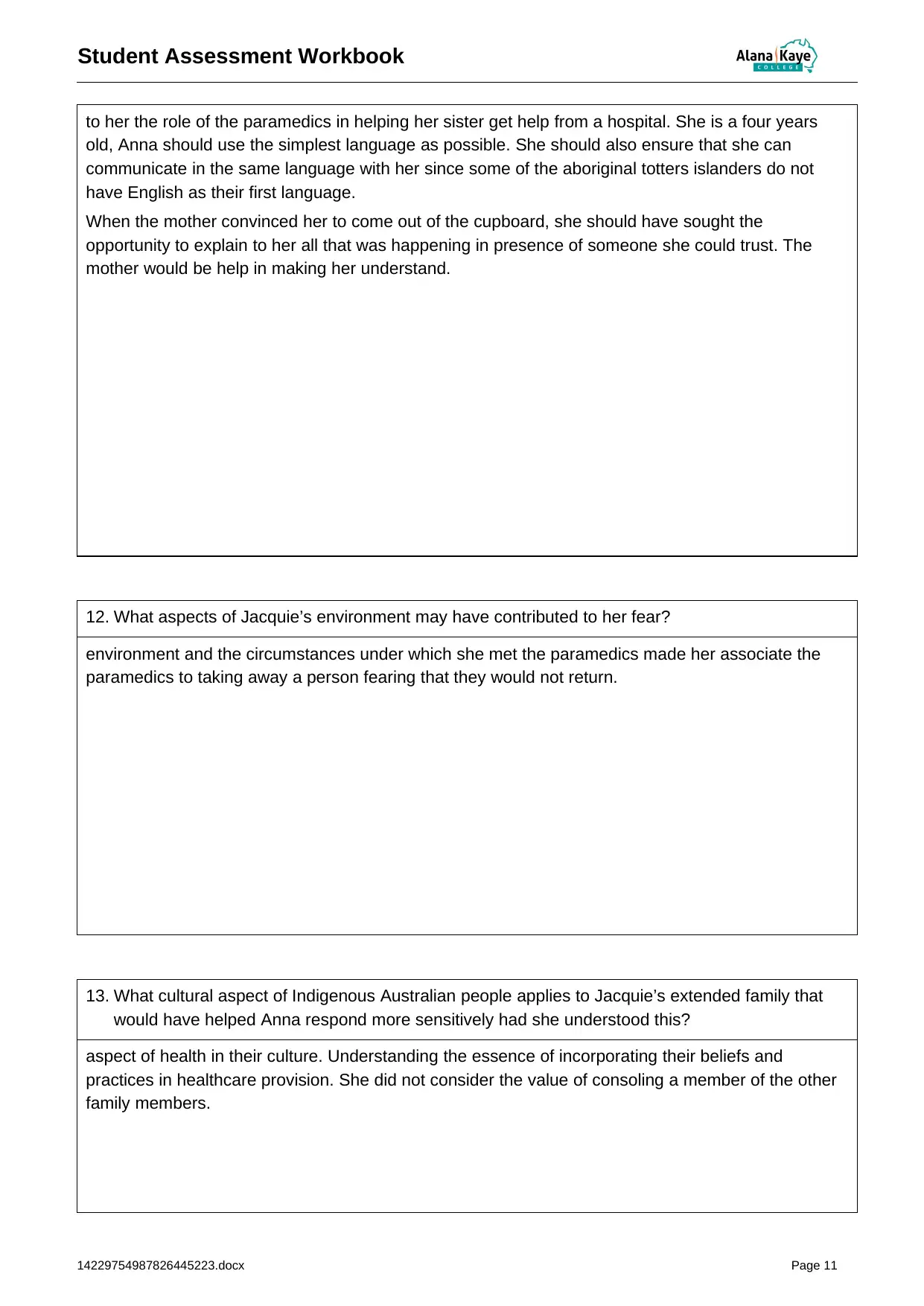
Student Assessment Workbook
to her the role of the paramedics in helping her sister get help from a hospital. She is a four years
old, Anna should use the simplest language as possible. She should also ensure that she can
communicate in the same language with her since some of the aboriginal totters islanders do not
have English as their first language.
When the mother convinced her to come out of the cupboard, she should have sought the
opportunity to explain to her all that was happening in presence of someone she could trust. The
mother would be help in making her understand.
12. What aspects of Jacquie’s environment may have contributed to her fear?
environment and the circumstances under which she met the paramedics made her associate the
paramedics to taking away a person fearing that they would not return.
13. What cultural aspect of Indigenous Australian people applies to Jacquie’s extended family that
would have helped Anna respond more sensitively had she understood this?
aspect of health in their culture. Understanding the essence of incorporating their beliefs and
practices in healthcare provision. She did not consider the value of consoling a member of the other
family members.
14229754987826445223.docx Page 11
to her the role of the paramedics in helping her sister get help from a hospital. She is a four years
old, Anna should use the simplest language as possible. She should also ensure that she can
communicate in the same language with her since some of the aboriginal totters islanders do not
have English as their first language.
When the mother convinced her to come out of the cupboard, she should have sought the
opportunity to explain to her all that was happening in presence of someone she could trust. The
mother would be help in making her understand.
12. What aspects of Jacquie’s environment may have contributed to her fear?
environment and the circumstances under which she met the paramedics made her associate the
paramedics to taking away a person fearing that they would not return.
13. What cultural aspect of Indigenous Australian people applies to Jacquie’s extended family that
would have helped Anna respond more sensitively had she understood this?
aspect of health in their culture. Understanding the essence of incorporating their beliefs and
practices in healthcare provision. She did not consider the value of consoling a member of the other
family members.
14229754987826445223.docx Page 11

Student Assessment Workbook
14. The Early Childhood Australia Code of Ethics includes responsibilities to families. Which code
could have helped Anna to manage this situation more effectively?
Respect the dignity and preferences of each family and endeavour to learn about their structure and lifestyle,
culture and customs, language, religion and beliefs. This would have helped her appreciate the culture of the
aboriginal Torres islanders and device a method of interacting with them effectively without infringing on their
culture
Read the case study, and then answer the questions that follow.
Case study
Sondra, an Indigenous Australian woman, comes into your service for the first time to inquire about
a health related issue. As you hand her some forms to fill out, she appears uncomfortable and
unsure of what to do.
15. Briefly discuss two ways you could make Sondra feel welcome and more relaxed in your service.
Give her an assurance that the information she will provide will held with utmost confidence. Assure
that the information will only accessed will only be accessed by the authorised personnel and will
only be used to provide the necessary care. The information provided will not be used to stereotype
or discriminate her.
By describing to her the essence of the information she is supposed to give. By making her
understand that information given has a bearing on the way health service will be provided. It will
help the care provider customise the service to her needs even incorporating her cultural beliefs and
traditions.
By ensuring that she understands what is expected of her. Enquiring whether she is comfortable with
communicating or writing in the language required in the form.
14229754987826445223.docx Page 12
14. The Early Childhood Australia Code of Ethics includes responsibilities to families. Which code
could have helped Anna to manage this situation more effectively?
Respect the dignity and preferences of each family and endeavour to learn about their structure and lifestyle,
culture and customs, language, religion and beliefs. This would have helped her appreciate the culture of the
aboriginal Torres islanders and device a method of interacting with them effectively without infringing on their
culture
Read the case study, and then answer the questions that follow.
Case study
Sondra, an Indigenous Australian woman, comes into your service for the first time to inquire about
a health related issue. As you hand her some forms to fill out, she appears uncomfortable and
unsure of what to do.
15. Briefly discuss two ways you could make Sondra feel welcome and more relaxed in your service.
Give her an assurance that the information she will provide will held with utmost confidence. Assure
that the information will only accessed will only be accessed by the authorised personnel and will
only be used to provide the necessary care. The information provided will not be used to stereotype
or discriminate her.
By describing to her the essence of the information she is supposed to give. By making her
understand that information given has a bearing on the way health service will be provided. It will
help the care provider customise the service to her needs even incorporating her cultural beliefs and
traditions.
By ensuring that she understands what is expected of her. Enquiring whether she is comfortable with
communicating or writing in the language required in the form.
14229754987826445223.docx Page 12
⊘ This is a preview!⊘
Do you want full access?
Subscribe today to unlock all pages.

Trusted by 1+ million students worldwide
1 out of 29
Related Documents
Your All-in-One AI-Powered Toolkit for Academic Success.
+13062052269
info@desklib.com
Available 24*7 on WhatsApp / Email
![[object Object]](/_next/static/media/star-bottom.7253800d.svg)
Unlock your academic potential
Copyright © 2020–2025 A2Z Services. All Rights Reserved. Developed and managed by ZUCOL.





